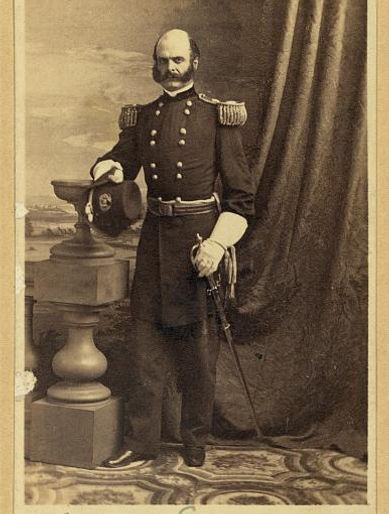
Arming the Union through Innovation, Genius, and Agency
Men, Machine, & the Carbine
"Burnsides's gun earned a distinguished military reputation, even if its inventor did not."
-- Roger Pauly
Firearms:
The Life Story of
A Technology,
page 93
The Inventor and his Company
The Burnside Carbine
PHOTO: LIBRARY OF CONGRESS
Brig. Gen. Ambrose E. Burnside c.1860-1880
The Bristol Rifle Works initially did not have large government orders. Secretary of War Jefferson Davis (in office from 1853 to 1857) bought several hundred Burnside carbines to equip the army.8 For example, the government purchased 200 carbines from the company on April 21, 1856 for $30 per carbine and 709 carbines from Bristol Fire Arms Company on September 21, 1858 for $35 per carbine.9 Reports dated March 6 and August 17, 1857 showed the government's tests viewed the Burnside positively at a time when carbines were not seen as an asset to the entire military's use (to cavalry but not infantry).10 At this point, Ambrose Burnside was still involved with his company.
a Two years after his graduation from West Point.11
b William Marvel in Burnside states that Ambrose Burnside resignation was accepted in October 1853.
1 William Marvell, Burnside (Chapel Hill: The University of North Carolina Press, 1991), 9 - 10.
2 Marvell, Burnside, 11; Arcadi Gluckman and L. D. Saterlee, American Gun Makers, 2nd ed. Revised (Harrisburg, Pennsylvania: The Telegraph Press, 1953), 25; Arcadi Gluckman, Identifying Old U.S. Muskets, Rifles & Carbines (New York: Bonanza Books, 1965), 329; William B. Edwards, Civil War Guns: The complete story of Federal and Confederate small arms: design, manufacture, identification, procurement, issue, employment, effectiveness, and postwar disposal (Secaucus, New Jersey: Castle, 1982), 114.
3 Marvell, Burnside, 11
4 Carl L. Davis, Arming the Union: Small Arms in the Civil War (Port Washington, New York: Kennikat Press, Inc., 1973), 120.
5 Norm Flayderman, Flayderman’s Guide to Antique American Firearms … and their values, 5th ed. (Northbrook: DBI Books, Inc., 1990), 491.
6 Roger Pauly, Firearms: The Life Story of a Technology (Baltimore: The John Hopkins University Press, 2004), 92.
7 Pauly, Firearms, 97
8 Marvell, Burnside, 12; Edwards, Civil War Guns, 115
9 Marvell, Burnside, 11; Gluckman and Saterlee, American Gun Makers, 2nd ed. Revised, 25; Arcadi Gluckman, Identifying Old U.S. Muskets, Rifles & Carbines, 329; Edwards, Civil War Guns, 115.
10 Davis, Arming America, 116
11 Edwards, Civil War Guns, 114; Margaret Wagner E., Gary W. Gallagher, and Paul Finkelman, eds., Civil War Reference Desk,
(New York, New York: Simon and Schuster, 2002), 406.
While Ambrose Burnside was a cavalry Lieutenant, he participated in a battle on Aug. 23, 1849a in New Mexico, where he was shot in the neck with an arrow by Apache Indians. That battle inspired the beginning ideas of his carbine. Burnside and his men could only use sabers in the battle. At that time, pistols were not widely used as an armament for cavalry. Burnside came up with the idea for his carbine to be a breechloader, because it was too awkward and difficult to load a rifle on horseback.1
While in the service, Ambrose Burnside fell on financial troubles and resigned from the army in 1853.b At that point, he decided that he was ready to perfect his carbine. Burnside borrowed money, bought machinery, and opened up his manufacturing company, Bristol Rifle Works, in 1855.2 Bristol Rifle Works, also known as Bristol Fire Arms Company, was named after the town that the company was located in.3
Ambrose Burnside was one of two inventors (the other was Gilbert Smith) that solved the problem of gas leaking through an unsealed chamber in the breech by changing the cartridge casing. The Burnside Cartridge was metal encased in paper.4 The cartridge itself was made out of copper or a “tapered foil."5 The ammunition had "a small hole in the center of the cartridge," which would allow the contents inside the shell to explode from the percussion ignition system.6 The bullet traveled the speed of 920 to 1000 feet per second.7
